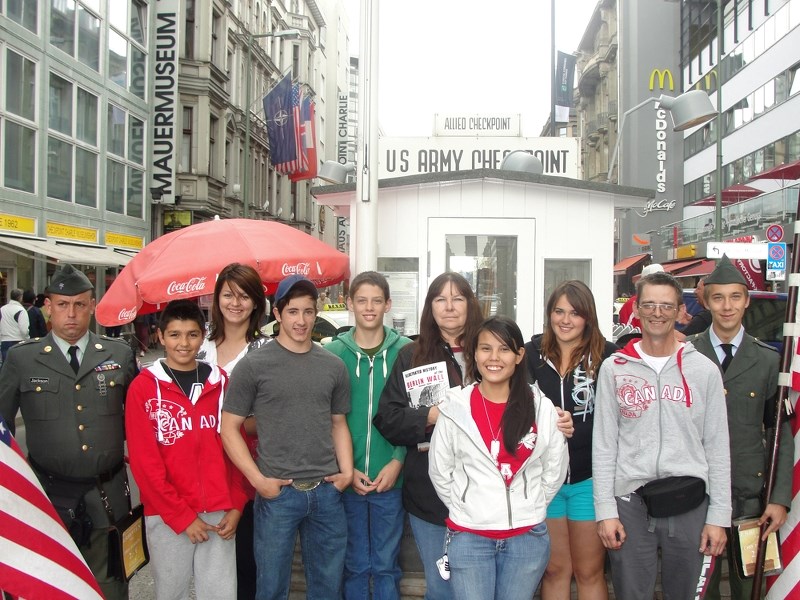The Vimy Ridge Interpretive Centre has become a yearly staple of the Mallaig Cadet Corps, and this year, six youth cadets took a trip over the Atlantic to see the real site first hand.
Sgt. Bianca Whiskeyjack, Warrant Officer Cody Smith, Warrant Officer T.J. Nelson, Sgt. Courtney Quinney, Warrant Officer Caroline Snyder and Master Cpl. Eagle Quinney were the lucky six to make the trip, chaperoned by Charlene Skeoch and John Brooker.
The group left Canada and headed to Europe on June 25, visiting Germany, the Netherlands, Belgium and France before returning home on July 4, but it was on Canada Day that the group arrived at the main destination, the Vimy Ridge Memorial.
While the cadets’ time at the memorial was limited, Skeoch said the group managed to squeeze out every ounce of the experience possible, exploring the trenches, underground tunnels, and of course, the memorial itself.
“That was the main thing that we went for, and we put a wreath there in memory,” Skeoch said. “It was a massive thing for us, but unfortunately we didn’t get the time that we wanted there to investigate. It was overwhelming, the size of it and the names all over . . . we went through all the trenches too, there were a bunch of trenches about half a mile from there.”
Whiskeyjack pointed out that it was interesting to see things that she had researched for the Vimy Ridge Interpretive Centre, such as the underground trenches.
“I was surprised at the trenches, and how they would go under the ground. I had read about that before, and how they had these runners that would transport messages, and they would usually get killed before they would deliver their messages,” she said. “I was also amazed by how many names were there and how many people died for us.”
Before departing the memorial site, Whiskeyjack shared a speech she wrote with the 45-person tour group that traveled to Vimy Ridge with the cadets. The speech surrounded the heroic efforts of William Johnstone Milne, a fallen soldier at the battle of Vimy Ridge.
“He actually saved his company twice from being shot at (by machine guns), in the end, when he got the second machine gun he was killed shortly after that,” Whiskeyjack said, adding that her fellow cadet, Eagle Quinney, also shared a speech on the steps of Vimy Ridge.
Whiskeyjack and Courtney Quinney will be next year’s ambassadors for the Mallaig Cadets Vimy Ridge interpretive centre, and Whiskeyjack noted that she already has some ideas for things to add or change.
“We have this little model of the Vimy Ridge trenches, so I was thinking about how we could put a second level on it and put the underground tunnels in,” she said, adding that it was a special moment for her, as an Aboriginal, to look for other Aboriginal names on the walls of the memorial. “There are a lot of names on there, and even though we’re Aboriginal, we can find names like ‘White’ or ‘Jackson’ on there.”
The Mallaig Cadets also made stops at the beaches Normandy and Juno Beach, and Skoech pointed out that she was surprised to find Normandy was comprised of gravel, not sand.
“When they say beaches of Normandy, you think of sand, but it was all gravel,” she said. “But it’s a beautiful little city.”
As a special activity, the cadets lined up where the beach meets the water, and sprinted up to the top while imagining they were Canadian soldiers, dodging bullets while toting 80 lb.-gear bags on D-Day.
“There was this guy that wanted us to do an interpretation of how they would land and run uphill while being shot at,” Whiskeyjack said. “It was actually easy to run up it, but when you think about it, and how much they had with them, it would have been really hard.”
The group also visited a number of historical attractions on the course of their trip, including Anne Frank’s house in Amsterdam, the Netherlands; the Flanders Field Museum in Ypres, Belgium; the Sachsenhausen concentration camp just outside Berlin, Germany, and the Berlin Wall.
Skeoch added that the tour group even made a stop at the gravesite of her third great uncle, James Ernest Skeoch, who died in World War I fighting with the Canadian Forces in France. Much to Skeoch’s surprise, her grandson, T.J. Nelson presented a wreath to his fallen ancestor at the site.
“It was about 20 km from Vimy Ridge, and so we went there and my grandson, T.J., he went right up to the grave, he saluted it, he placed a wreath and he got up and saluted it again,” she said, adding that it brought a tear to her eye. “I didn’t expect that.”



